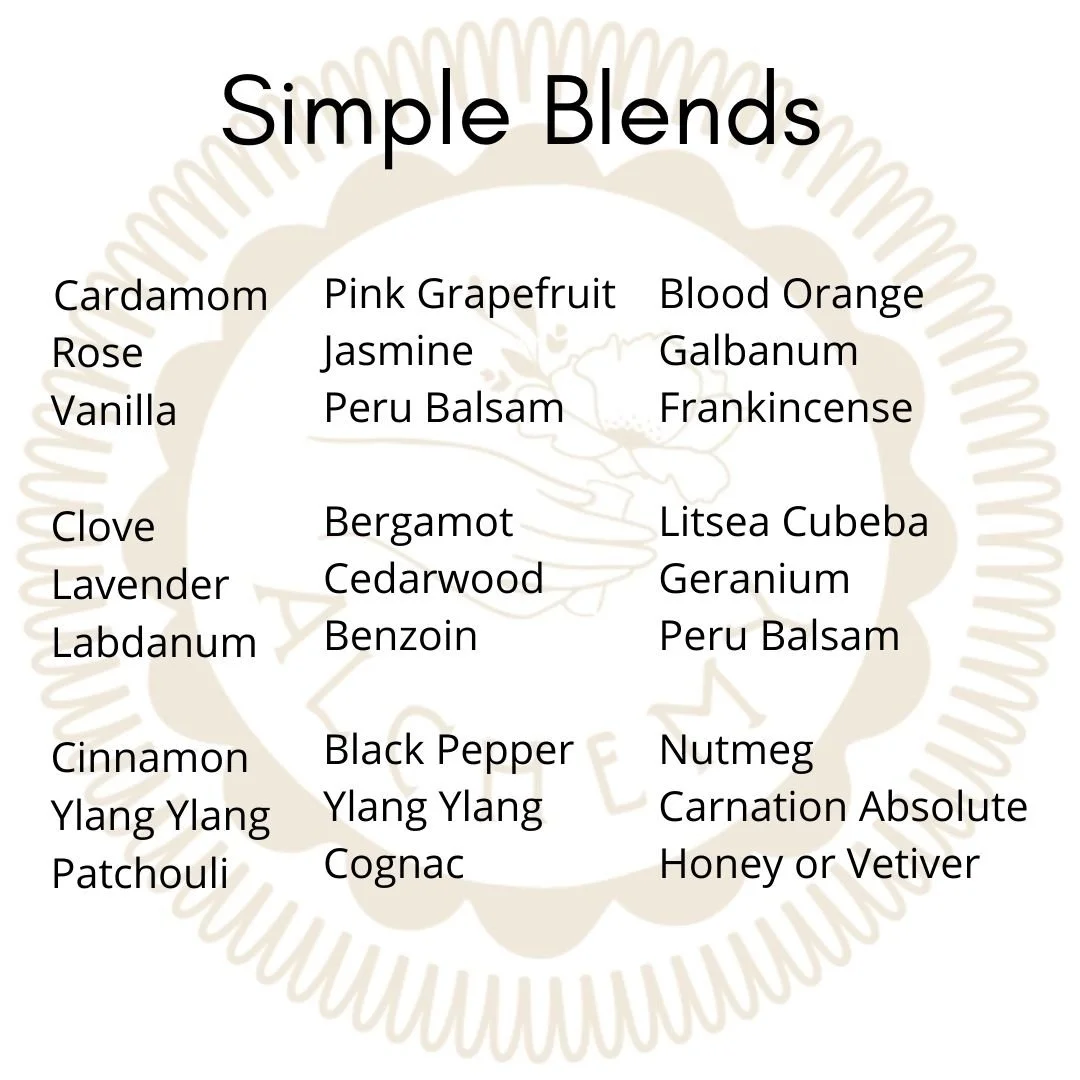Simple Fragrance Blends
Want to experiment with perfume blending and natural essences? It can be tricky to know where to start.
You can find a recommended reading list here.
If you’re the kind of person who likes to jump in and experiment, or if you’ve taken a workshop with me and want do delve a little deeper on your own, this is for you!
When you’re taking a workshop with all these gorgeous aromas, some you’ve never had a chance to play with before, it’s easy to get overwhelmed. It’s also easy to ‘go crazy’ and end up with a muddy and unfocused fragrance.
A few years ago I attended a cologne workshop with perfumer Charna Ethier of Providence Perfume. During the three day workshop one of our assignments was to create a fragrance using the fewest possible ingredients. This was the ‘birth’ of Le Fete, and a super instructive exercise in FOCUS.
Fragrance designers start their process with a ‘brief’ that helps inform the work-flow. The brief describes the end goal for the perfume and may include a description of the aroma or an exploration of an ingredient. In the case of Le Fete, I knew I wanted to use the Apricot Melange by Robertet to create a perfume that was flirty, like one too many cocktails at a garden party.
Because the ingredients themselves are really complex, the whole formula is six essences.
Simple Blends
I have collected for you a nine three ingredient combinations to try at home. They can be blended to proportions for home fragrance, bath salts or soaks, and as a perfume to wear.
Each grouping has three ingredients: top, middle, and base note. Use them as a final blend, or the framework. Most ingredients are available from Eden Botanicals in sample sizes that can be diluted into your carrier (an oil such as moringa seed or jojoba) or into alcohol.
Most readers will know that fragrance conversations often focus on the base, middle and top notes of the scent. But as you dig deeper you’ll begin to see that most individual essences have elements of all three. The character changes from first whiff to last sniff.
Generally speaking top notes are citrus or spices, heart notes often flowers and base notes are often resins, balsam, and roots (frankincense, vetiver).
In a future post, I’ll have some base accords for you to use that will add depth and character to your fragrance. But starting here, and having, noticing the interplay of aromas as you blend, and developing a clear brief, will help you immensely when you move forward with your fragrance design.
Cardamom, Rose, Vanilla
Clove, Lavender absolute, Labdanum
Cinnamon Leaf, Ylang Ylang, Patchouli
Pink Grapefruit, Jasmine, Peru Balsam
Bergamot, Cedarwood, Benzoin
Black Pepper, Ylang Ylang, Cognac
Blood Orange, Galbanum, Peru Balsam
Nutmeg, Carnation Absolute, Honey or Vetiver
LItsea Cubeba, Geranium Bourbon, Peru Balsam
Formulating
When making your formula give yourself a ‘drop budget’ in 1 tablespoon of your carrier (oil or alcohol). Forty-eight drops works well for 50% base, 30% heart, 20% top –
That gives you 24 drops base, 16 drops heart, 8 drops top- - Feel free to make several small batches and decide which is most pleasing.
Instead of dumping all the drops in at once, play with it, add half your drop budget per top, middle and base and adjust from there. Take lots of notes!
Buying the ingredients
I’d start with Eden Botanicals because you can get samples that can be diluted before blending.
Invest in some wide mouth vials with tight lids for storing your dilutions and creating your tests.
Water color paper cut in thin strips makes a good tester strip. Be sure to write the aroma name and time so you can notice changes.
Cheap vodka makes a good diluetant for room mists
Jojoba oil is a good material for diluting for using as a perfume oil, body oil or bath soak



